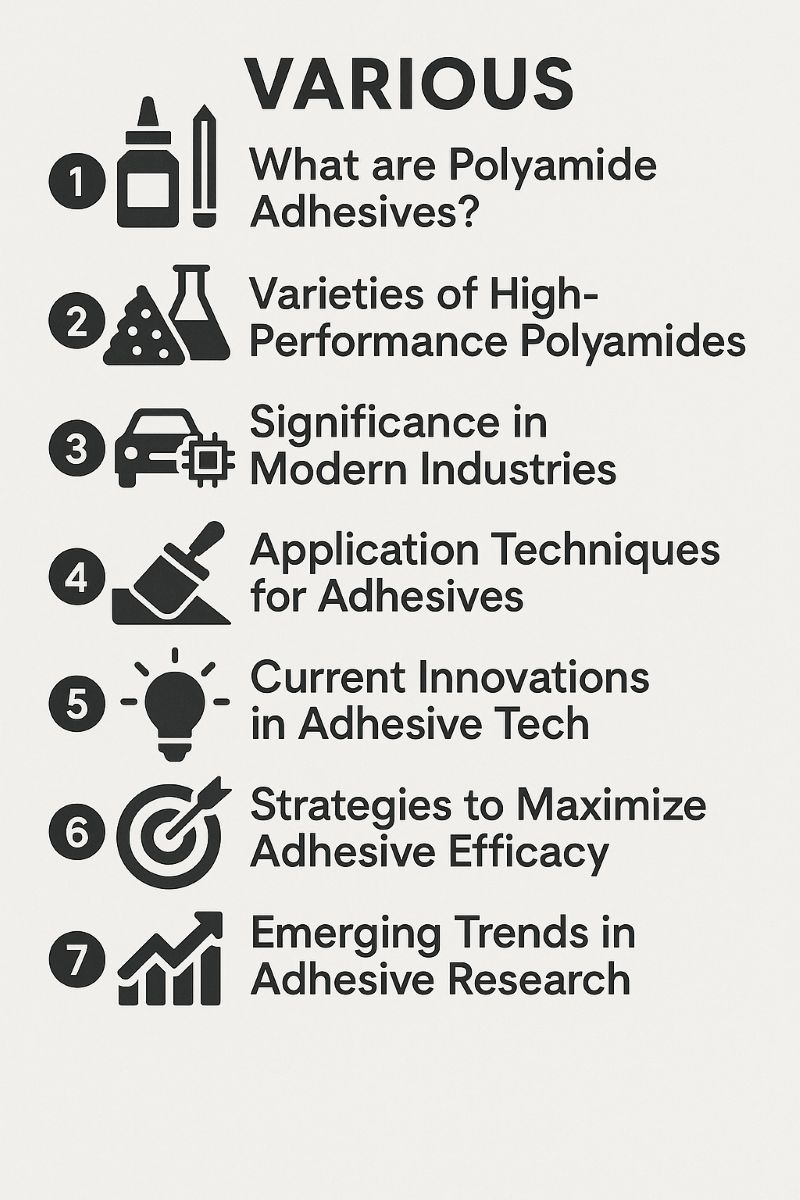
What are Polyamide Adhesives?
Varieties of High-Performance Polyamides
Significance in Modern Industries
Application Techniques for Adhesives
Current Innovations in Adhesive Tech
Strategies to Maximize Adhesive Efficacy
Emerging Trends in Adhesive Research
Frequently Asked Questions (FAQ)
Polyamide adhesives are widely recognized for their strength, chemical resistance, and durability under thermal and mechanical stress. Derived from polyamide polymers, these adhesives are frequently used in high-performance bonding applications across various industries, including automotive, aerospace, and electronics. They support robust and long-lasting joints, ensuring reliability in complex assemblies that must endure harsh environments.
High-performance polyamides are formulated with specific end-use applications in mind. These variants are engineered to resist extreme heat, chemical exposure, and mechanical fatigue, making them suitable for use in industrial sectors with stringent performance demands. Polyamide adhesives can be tailored for fast setting, enhanced thermal stability, or exceptional toughness, depending on operational requirements.
Polyamide adhesives play a critical role in today’s manufacturing and engineering sectors. Their ability to form strong, durable bonds under challenging conditions makes them indispensable in automotive component assembly, aerospace systems, electronics packaging, and filtration products. These adhesives contribute to enhanced product safety, extended service life, and reduced maintenance frequency—factors that are vital in competitive markets.
Applying polyamide adhesives effectively requires attention to detail:
Surface Preparation: Clean, dry, and contaminant-free surfaces ensure optimal adhesion.
Temperature Control: Adhesives should be applied within the specified processing window.
Dispensing Tools: Applicator guns or automated systems help deliver precise and uniform coverage.
Understanding the viscosity and setting characteristics of the adhesive allows users to fine-tune application techniques for peak performance and minimal waste.
The adhesive industry continues to innovate rapidly. Recent developments in polyamide hot melt technology have focused on:
Faster curing profiles for high-speed manufacturing lines
Lower VOC emissions for environmentally sensitive applications
Improved thermal endurance for next-generation electronics and transport systems
These innovations allow manufacturers to meet evolving regulatory requirements while maintaining high bond quality and reliability.
To achieve consistent bonding outcomes, manufacturers should:
Match adhesive properties to the thermal and mechanical demands of the application
Use precise application tools to ensure uniform adhesive coverage
Implement robust quality control checks during dispensing and curing
Store and handle adhesives in accordance with supplier guidelines to maintain stability
By aligning these strategies with the product's technical specifications, manufacturers can reduce rework and improve production efficiency.
The field of adhesive research is increasingly focused on:
Sustainability: Developing formulations with reduced environmental impact
Customization: Engineering adhesives tailored to specific substrates and operating conditions
Multifunctionality: Combining adhesive bonding with thermal conductivity, electrical insulation, or vibration damping
These trends indicate a shift toward adhesives that not only bond but also enhance system-level performance in complex environments.
What are polyamide adhesives?
They are high-strength bonding agents based on polyamide polymers, known for their chemical resistance and performance under high temperature and stress.
What types of polyamide adhesives exist?
Formulations vary from fast-setting to highly thermally stable and mechanically tough variants, each designed to meet specific industrial needs.
Why are polyamide adhesives important in modern industries?
They provide reliable performance in harsh environments, enabling durable product assembly in sectors like transportation, electronics, and filtration.
What are best practices for applying polyamide adhesives?
Ensure proper surface preparation, use the right temperature range during application, and apply with suitable tools for even coverage.
What are recent innovations in adhesive technology?
Recent advances include low-VOC, fast-curing, and high-heat-resistant adhesives tailored for automated production and extreme operating conditions.
How can adhesive performance be optimized?
Select adhesives based on substrate compatibility and use controlled application methods to ensure strong and consistent bonds.
What trends are influencing the future of adhesive development?
Trends include environmentally conscious formulations, smart materials with added functionality, and application-specific customization.
Which industries benefit most from polyamide adhesives?
Industries such as automotive, aerospace, electronics, and filtration benefit from their strength, chemical resistance, and durability under pressure.